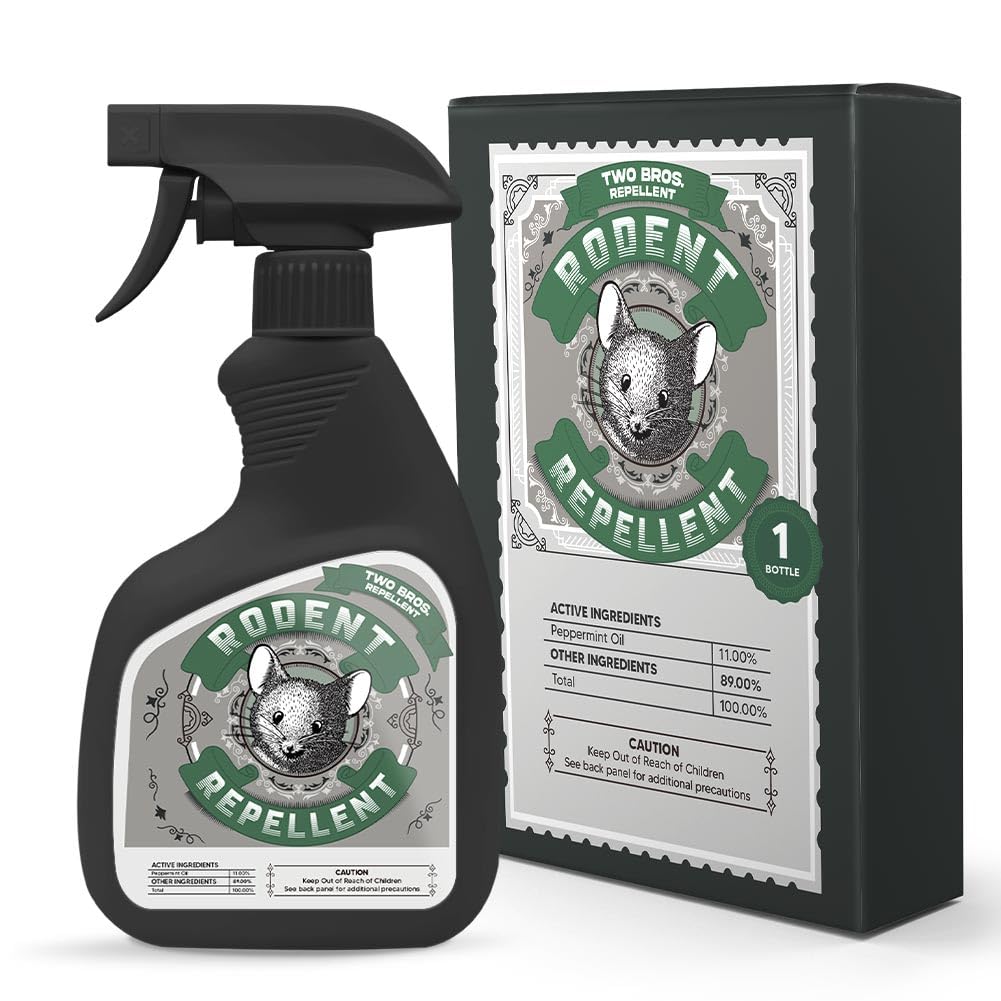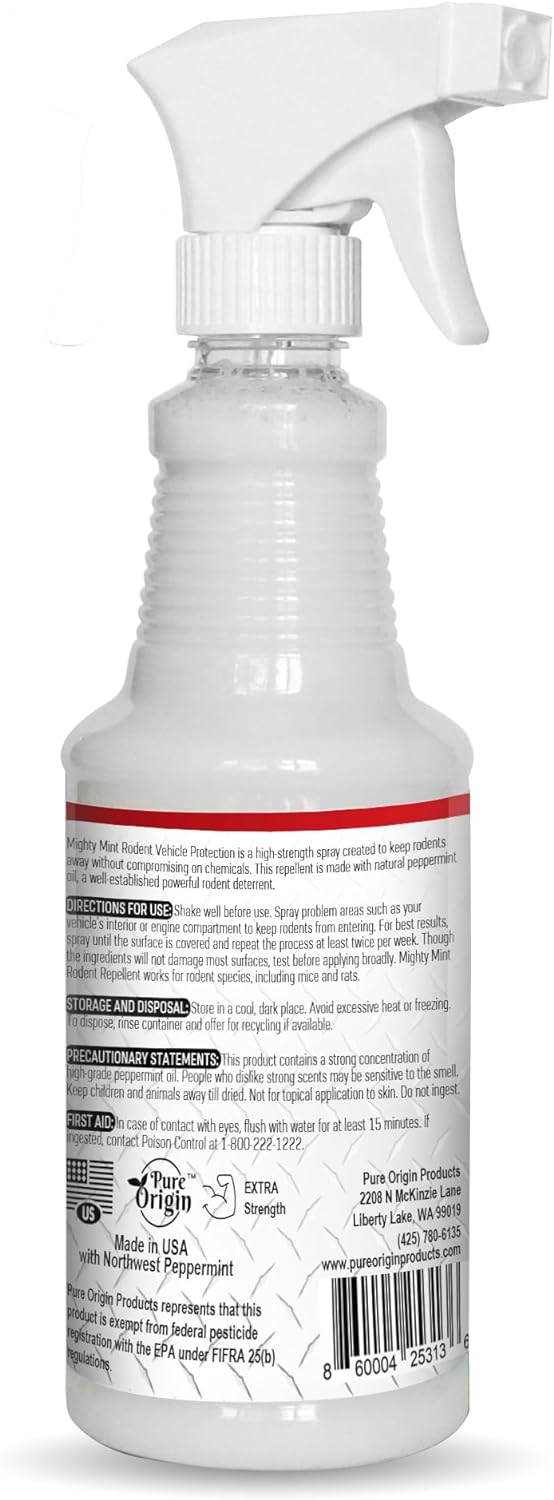
Vehicles often become unintentional havens for rodents, providing them with warmth, shelter, and easy access to food sources. Unfortunately, these uninvited guests can cause significant damage to vehicles, including gnawing on wires, hoses, and upholstery, leading to costly repairs and even electrical fires. To combat this issue, rodent repellent sprays have emerged as a popular solution for deterring rodents from entering and damaging vehicles.
Types of Rodent Repellent Sprays
Rodent repellent sprays come in a variety of forms, each utilizing different mechanisms to discourage rodents from approaching vehicles. Common types include:
-
Peppermint-based sprays: The strong, pungent odor of peppermint is highly unpleasant to rodents, making it an effective repellent.
-
Ultrasonic rodent repellents: These devices emit high-frequency sounds that are beyond the range of human hearing but are irritating to rodents, driving them away.
-
Mothballs: Mothballs contain naphthalene, a chemical with a strong odor that repels rodents.

Choosing the Right Rodent Repellent Spray
The choice of rodent repellent spray depends on individual preferences and the specific needs of the vehicle owner. Here are some factors to consider:
-
Effectiveness: Consider the strength and reputation of the repellent spray in deterring rodents.
-
Ease of application: Choose a spray that is easy to apply and reapply regularly.
-
Safety: Ensure the repellent is safe for use around vehicles and does not pose any health hazards.
-
Additional features: Some sprays offer additional benefits, such as weather resistance or extended protection.
Applying Rodent Repellent Sprays
Proper application of rodent repellent sprays is crucial for their effectiveness. Follow these guidelines:
-
Safety precautions: Wear gloves and a mask when handling the spray and work in a well-ventilated area.
-
Preparation: Clean the engine compartment to remove any debris or food sources that may attract rodents.
-
Application: Shake the spray bottle well and apply the repellent generously to all areas where rodents are likely to enter, such as around wires, hoses, and air vents.
-
Reapplication: Reapply the repellent regularly, especially after heavy rains or car washes.

Maintaining Rodent Repellent Protection
Beyond regular application, additional measures can help prevent rodent infestations:
-
Eliminate food sources: Keep food and drinks out of the vehicle and clean up any spills promptly.
-
Seal entry points: Inspect the vehicle for any gaps or holes that rodents could use to enter and seal them with caulk or metal mesh.
-
Store vehicles securely: Park vehicles in garages or well-lit areas whenever possible.
Troubleshooting
If you encounter issues with rodent repellent sprays, consider these troubleshooting tips:
-
Ineffective repellent: Try a different type of repellent or a stronger concentration of the same product.
-
Improper application: Ensure thorough coverage and reapply more frequently.
-
Persistent infestation: Consult a professional pest control service for a more comprehensive solution.
Conclusion
Rodent repellent sprays can be an effective tool in preventing costly rodent damage to vehicles. By choosing the right repellent, applying it properly, and maintaining a rodent-free environment, vehicle owners can safeguard their cars from these unwelcome pests.
Glossary
In this section, define key terms used throughout the blog post to ensure reader understanding:
- Rodent: A small mammal such as a mouse, rat, or squirrel.
- Repellent: A substance that discourages pests from approaching an area.
- Naphthalene: A chemical compound with a strong odor, found in mothballs.
- Ultrasonic: Referring to sound waves with frequencies higher than the range of human hearing.
- Caulk: A sealant used to fill gaps or cracks.
- Infestation: A large number of unwanted pests inhabiting a specific area.
Environmental Considerations
While rodent repellent sprays can be effective, it’s important to consider their potential environmental impact. Some sprays contain harsh chemicals that can harm wildlife or pollute waterways if not used properly. Explore these considerations:
- Look for sprays made with natural ingredients like peppermint oil, which are less harmful to the environment.
- Dispose of empty spray cans responsibly according to local regulations.
- Consider using traps or ultrasonic repellents as alternatives, which may have a lower environmental impact.

Long-Term Rodent Control Strategies
Rodent repellent sprays can be a temporary solution. Here are some long-term strategies for preventing rodent infestations:
- Maintain a clean environment: Regularly clean your garage or storage area to remove debris and food sources that attract rodents.
- Address potential entry points: Seal any cracks or holes in your garage or shed that rodents could use to enter.
- Store food properly: Keep pet food and other potential food sources in airtight containers.
- Consider professional pest control: If you have a recurring rodent problem, consult a professional pest control service for a more comprehensive solution.
-
Important Disclaimer
It’s important to remember that rodent repellent sprays are not a guaranteed solution. Rodents are persistent creatures and may adapt to the repellent over time. Here are some additional points to consider:
- Severity of infestation: For severe infestations, repellent sprays alone may not be sufficient. Combining them with traps or professional pest control services might be necessary.
- Pet safety: Certain rodent repellent sprays may be harmful to pets. Choose a pet-safe option or keep pets away from treated areas until the spray dries completely.
By understanding these limitations and taking appropriate precautions, you can maximize the effectiveness of rodent repellent sprays and protect your vehicle from these unwelcome guests.
-
Homemade Rodent Repellents
While commercially available rodent repellent sprays offer convenience, some prefer a more natural or budget-friendly approach. Here are a few homemade options to consider:
-
Peppermint oil: Mix a few drops of peppermint oil with water in a spray bottle. Apply the solution to areas where rodents are likely to enter. The strong scent of peppermint is a natural deterrent.
-
Cayenne pepper: Sprinkle cayenne pepper around potential entry points. Rodents dislike the burning sensation it creates on their noses and feet. However, this method can be messy and may irritate your eyes or respiratory system if not handled carefully.
Important Note: Homemade solutions may not be as effective or long-lasting as commercial sprays. Additionally, some materials, like cayenne pepper, can be irritating. Always test these options in a small, inconspicuous area before applying them liberally and wear gloves and a mask for protection when handling with them.
-
Leave a Reply